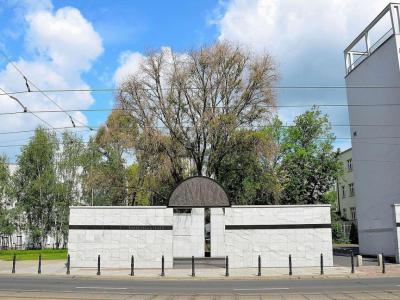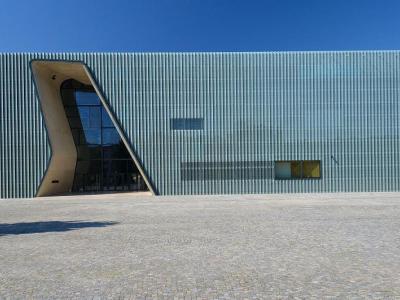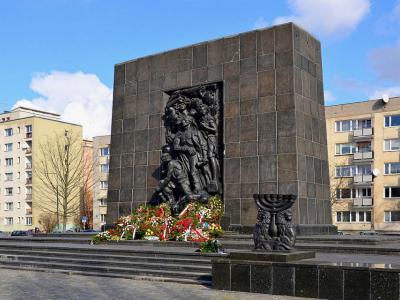
Jewish Warsaw Walking Tour (Self Guided), Warsaw
Once abundant, the Jewish population of Warsaw has left a profound mark on the city. Nowadays, walking along the peaceful streets of Poland's capital it is hard to imagine that thousands of Jews were once herded here and forced into cattle cars to meet their end in the Nazi concentration camps during World War II.
At the heart of this tragic chapter in Warsaw's Jewish history lies the so-called “gathering point” (Umschlagplatz). A place of deep significance, it marks the site on which thousands of Jews were gathered for deportation. Some 400,000 of them never came back.
The POLIN Museum of the History of Polish Jews stands as a testament to the vibrant Jewish community that once thrived in the city. This world-class museum chronicles centuries of Jewish life in Poland and serves as a place of education and remembrance.
The Monument to the Ghetto Heroes is a solemn tribute to those who resisted the oppression of the Nazis during the Warsaw Ghetto Uprising – a symbol of courage and resilience in the face of unimaginable adversity.
The Jewish Historical Institute is another essential institution, preserving archives and research related to Jewish history in Poland. It serves as a valuable resource for scholars and anyone interested in exploring this heritage.
Nozyk Synagogue, a surviving pre-war synagogue, is a beautiful architectural gem and a place of worship for the Jewish community today. It bears witness to the enduring spirit of Jewish faith in Warsaw.
The Janusz Korczak Monument honors the memory of a Jewish-Polish educator who dedicated his life to caring for orphaned Jewish children, embodying the values of compassion and humanity.
Finally, the remnants of the Warsaw Ghetto Walls, though mostly gone, remind us of the physical and emotional barriers that once confined the Jewish population.
Time goes on and it is essential that we visit such places in Warsaw or elsewhere to gain a deeper understanding of what happened and to ensure that the lessons of the past are not forgotten in the generations to come.
At the heart of this tragic chapter in Warsaw's Jewish history lies the so-called “gathering point” (Umschlagplatz). A place of deep significance, it marks the site on which thousands of Jews were gathered for deportation. Some 400,000 of them never came back.
The POLIN Museum of the History of Polish Jews stands as a testament to the vibrant Jewish community that once thrived in the city. This world-class museum chronicles centuries of Jewish life in Poland and serves as a place of education and remembrance.
The Monument to the Ghetto Heroes is a solemn tribute to those who resisted the oppression of the Nazis during the Warsaw Ghetto Uprising – a symbol of courage and resilience in the face of unimaginable adversity.
The Jewish Historical Institute is another essential institution, preserving archives and research related to Jewish history in Poland. It serves as a valuable resource for scholars and anyone interested in exploring this heritage.
Nozyk Synagogue, a surviving pre-war synagogue, is a beautiful architectural gem and a place of worship for the Jewish community today. It bears witness to the enduring spirit of Jewish faith in Warsaw.
The Janusz Korczak Monument honors the memory of a Jewish-Polish educator who dedicated his life to caring for orphaned Jewish children, embodying the values of compassion and humanity.
Finally, the remnants of the Warsaw Ghetto Walls, though mostly gone, remind us of the physical and emotional barriers that once confined the Jewish population.
Time goes on and it is essential that we visit such places in Warsaw or elsewhere to gain a deeper understanding of what happened and to ensure that the lessons of the past are not forgotten in the generations to come.
How it works: Download the app "GPSmyCity: Walks in 1K+ Cities" from Apple App Store or Google Play Store to your mobile phone or tablet. The app turns your mobile device into a personal tour guide and its built-in GPS navigation functions guide you from one tour stop to next. The app works offline, so no data plan is needed when traveling abroad.
Jewish Warsaw Walking Tour Map
Guide Name: Jewish Warsaw Walking Tour
Guide Location: Poland » Warsaw (See other walking tours in Warsaw)
Guide Type: Self-guided Walking Tour (Sightseeing)
# of Attractions: 7
Tour Duration: 2 Hour(s)
Travel Distance: 4.7 Km or 2.9 Miles
Author: leticia
Sight(s) Featured in This Guide:
Guide Location: Poland » Warsaw (See other walking tours in Warsaw)
Guide Type: Self-guided Walking Tour (Sightseeing)
# of Attractions: 7
Tour Duration: 2 Hour(s)
Travel Distance: 4.7 Km or 2.9 Miles
Author: leticia
Sight(s) Featured in This Guide:
- Umschlagplatz
- POLIN Museum of the History of Polish Jews
- Monument to the Ghetto Heroes
- Jewish Historical Institute
- Nozyk Synagogue
- Janusz Korczak Monument
- Warsaw Ghetto Walls
1) Umschlagplatz
The tragic history of Polish Jews who perished during the Holocaust is shared at the Umschlagplatz Monument. Umschlagplatz, a German word meaning "collection point," is the location where Jews from Warsaw were held to be taken to Nazi death camps.
Visitors to Warsaw can observe the Umschlagplatz Monument at the end of the Memorial Route of Jewish Martyrdom and Struggle. It is engraved with the 448 most popular Jewish names, which are meant to represent the Jews who were sent to Treblinka, and then murdered at the hands of Nazis. The Umschlagplatz Monument honors their memories with its design, which represents the colors of Jewish ritual robes.
The monument was completed in 1988 and unveiled on the 45th anniversary of the beginning of the Ghetto Uprising. It includes two inscriptions that commemorate the lives lost and include a verse from the Book of Job in Polish, Hebrew and Yiddish.
Visitors to Warsaw can observe the Umschlagplatz Monument at the end of the Memorial Route of Jewish Martyrdom and Struggle. It is engraved with the 448 most popular Jewish names, which are meant to represent the Jews who were sent to Treblinka, and then murdered at the hands of Nazis. The Umschlagplatz Monument honors their memories with its design, which represents the colors of Jewish ritual robes.
The monument was completed in 1988 and unveiled on the 45th anniversary of the beginning of the Ghetto Uprising. It includes two inscriptions that commemorate the lives lost and include a verse from the Book of Job in Polish, Hebrew and Yiddish.
2) POLIN Museum of the History of Polish Jews (must see)
The POLIN Museum of the History of Polish Jews opened in 2013. The museum focuses on Jews in Poland from the Middle Ages through present day. It has a strong focus on the Holocaust, but it covers more than 1000 years of Jewish history.
The core exhibition has eight galleries that include artifacts and information detailing the arrival of Jewish people, their settlement and their culture. There are interactive exhibits, films, artwork and photos that work together to provide a narrative history.
Rotating exhibits vary. They often focus on visual art, photography and history. These temporary exhibits are sometimes on display for as long as six months or as short as only a few weeks. Thanks to the broad range of rotating exhibits and the importance of the core exhibition, the POLIN Museum of the History of Polish Jews received the European Museum of the Year Award in 2016.
The museum is located on the site of the former Warsaw Ghetto. It was designed by architects Rainer Mahlamäki and Ilmari Lahdelma in a Postmodern Architectural style using concrete, copper and glass. The imposing, box-shaped building stands in contrast to the surrounding green space where it sits. The award-winning building is illuminated at night in multiple colors.
The core exhibition has eight galleries that include artifacts and information detailing the arrival of Jewish people, their settlement and their culture. There are interactive exhibits, films, artwork and photos that work together to provide a narrative history.
Rotating exhibits vary. They often focus on visual art, photography and history. These temporary exhibits are sometimes on display for as long as six months or as short as only a few weeks. Thanks to the broad range of rotating exhibits and the importance of the core exhibition, the POLIN Museum of the History of Polish Jews received the European Museum of the Year Award in 2016.
The museum is located on the site of the former Warsaw Ghetto. It was designed by architects Rainer Mahlamäki and Ilmari Lahdelma in a Postmodern Architectural style using concrete, copper and glass. The imposing, box-shaped building stands in contrast to the surrounding green space where it sits. The award-winning building is illuminated at night in multiple colors.
3) Monument to the Ghetto Heroes
Only a couple of blocks away from the Umschlagplatz Monument is the Monument to the Ghetto Heroes. This monument commemorates 1943's Warsaw Ghetto Uprising. It is located on the grounds of the POLIN Museum of the History of Polish Jews in the same area where the uprising took place.
The Monument of the Ghetto Heroes was erected in 1948. It was sculpted by Nathan Rapaport under the direction of Leon Suzin. This monument expanded upon Suzin's earlier work, which was a small, circular plaque placed in the same location only two years earlier.
The Monument to the Ghetto Heroes is built in the form of a 36-foot wall. It is meant to represent both the uprising and the Western Wall in Jerusalem. The monument is adorned with busts of citizens holding Molotov cocktails and Jewish people being persecuted by Nazis. It also includes the image of the leader of Zydowska Organizacja Bojowa (ZOB), Mordechai Anielewicz.
Tourists can view this monument as part of a walking history tour of Poland or during their visit to the POLIN Museum of the History of Polish Jews. As it is an outdoor monument facing a public street, there is no admission and visitors can view the monument at any time.
The Monument of the Ghetto Heroes was erected in 1948. It was sculpted by Nathan Rapaport under the direction of Leon Suzin. This monument expanded upon Suzin's earlier work, which was a small, circular plaque placed in the same location only two years earlier.
The Monument to the Ghetto Heroes is built in the form of a 36-foot wall. It is meant to represent both the uprising and the Western Wall in Jerusalem. The monument is adorned with busts of citizens holding Molotov cocktails and Jewish people being persecuted by Nazis. It also includes the image of the leader of Zydowska Organizacja Bojowa (ZOB), Mordechai Anielewicz.
Tourists can view this monument as part of a walking history tour of Poland or during their visit to the POLIN Museum of the History of Polish Jews. As it is an outdoor monument facing a public street, there is no admission and visitors can view the monument at any time.
4) Jewish Historical Institute
The Jewish Historical Institute is a body that researches the history of Jews in Poland. The institute was founded in 1947.
The institute holds documents relating to historic events. The primary collection focuses on the Warsaw Ghetto Uprising. The Jewish Historical Institute holds more than 6,000 documents relating to this event. The institute also has diaries, memoirs and other documents relating to Jews who lived in Poland during World War II.
Not all collections are open to the public. Some, particularly those that pertain to academic research, must be requested well in advance. However, there are public exhibits that patrons are welcome to view.
The Underground Archive of the Warsaw Ghetto is a permanent exhibit that displays documentation, letters and testimonies related to the Warsaw Ghetto. The House of Prayer replicates a traditional synagogue with artifacts dating to the 18th century. Though they survived World War II, many are damaged with battle scars incurred during that time.
The photography collection offers more than 40,000 photographs of Jewish people in Poland through the years. Artwork and temporary exhibits are regularly offered at the institute.
The institute holds documents relating to historic events. The primary collection focuses on the Warsaw Ghetto Uprising. The Jewish Historical Institute holds more than 6,000 documents relating to this event. The institute also has diaries, memoirs and other documents relating to Jews who lived in Poland during World War II.
Not all collections are open to the public. Some, particularly those that pertain to academic research, must be requested well in advance. However, there are public exhibits that patrons are welcome to view.
The Underground Archive of the Warsaw Ghetto is a permanent exhibit that displays documentation, letters and testimonies related to the Warsaw Ghetto. The House of Prayer replicates a traditional synagogue with artifacts dating to the 18th century. Though they survived World War II, many are damaged with battle scars incurred during that time.
The photography collection offers more than 40,000 photographs of Jewish people in Poland through the years. Artwork and temporary exhibits are regularly offered at the institute.
5) Nozyk Synagogue
The Nożyk Synagogue, located in Warsaw, stands as a poignant historical monument and the sole prewar Jewish house of prayer in Warsaw to have survived the tumultuous events of World War II. Its establishment dates back to the late 19th century, a period when Warsaw's Jewish community, one of the largest globally, had over 400 houses of prayer. Among these, only two were independent structures, with the majority being smaller chapels integrated into schools, hospitals, or homes.
This synagogue's history began when the need for a temple for the orthodox Jewry of Warsaw became apparent. Responding to this need, Zalman Nożyk, a prominent Warsaw merchant, and his wife Ryfka financed the construction of this temple on Twarda street, near Grzybów and Grzybowski Square. The construction spanned from 1898 to 1902.
The architectural design of the Nożyk Synagogue was the work of Karol Kozłowski, a renowned Warsaw architect also credited with designing the Warsaw Philharmonic Orchestra Hall. The building's façade exhibits a neo-Romanticist style with distinct neo-Byzantine elements. The structure is rectangular, featuring an internal chamber divided into three aisles.
The synagogue's history is marked by World War II tragedies. In 1939, it was damaged in an air raid. During the war, it became part of the Small Ghetto, witnessing the Ghetto Uprising and later being repurposed as stables and a depot by the Nazis. After the war, it was restored and now serves as a place of worship, housing the Warsaw Jewish Commune and other Jewish organizations, a testament to the resilience of Warsaw's Jewish community.
This synagogue's history began when the need for a temple for the orthodox Jewry of Warsaw became apparent. Responding to this need, Zalman Nożyk, a prominent Warsaw merchant, and his wife Ryfka financed the construction of this temple on Twarda street, near Grzybów and Grzybowski Square. The construction spanned from 1898 to 1902.
The architectural design of the Nożyk Synagogue was the work of Karol Kozłowski, a renowned Warsaw architect also credited with designing the Warsaw Philharmonic Orchestra Hall. The building's façade exhibits a neo-Romanticist style with distinct neo-Byzantine elements. The structure is rectangular, featuring an internal chamber divided into three aisles.
The synagogue's history is marked by World War II tragedies. In 1939, it was damaged in an air raid. During the war, it became part of the Small Ghetto, witnessing the Ghetto Uprising and later being repurposed as stables and a depot by the Nazis. After the war, it was restored and now serves as a place of worship, housing the Warsaw Jewish Commune and other Jewish organizations, a testament to the resilience of Warsaw's Jewish community.
6) Janusz Korczak Monument
The Janusz Korczak Monument was erected in honor of educator and author, Janusz Korczak. Korczak was a well-known author of children's books who later took over as principal at an orphanage for Jewish children. During the Holocaust, Korczak was offered the opportunity to escape. However, he refused to leave the orphans behind and instead accompanied them to the Treblinka extermination camp and was not heard from again.
The monument shows Korczak with some of his pupils. It is erected at the site of the orphanage in what was formerly the Warsaw Ghetto. Though plans for the monument were underway in 1999, it wasn't completed and unveiled until 2006.
Visitors can find the monument in Świętokrzyski Park near the Palace of Culture and Science. Tourists who want to see other statues and monuments honoring Korczak can find them through Warsaw. A commemorative grave in the Jewish ceremony also holds important meaning to those wishing to honor Korczak's legacy.
The monument shows Korczak with some of his pupils. It is erected at the site of the orphanage in what was formerly the Warsaw Ghetto. Though plans for the monument were underway in 1999, it wasn't completed and unveiled until 2006.
Visitors can find the monument in Świętokrzyski Park near the Palace of Culture and Science. Tourists who want to see other statues and monuments honoring Korczak can find them through Warsaw. A commemorative grave in the Jewish ceremony also holds important meaning to those wishing to honor Korczak's legacy.
7) Warsaw Ghetto Walls
In the hard and terrible times of 1940, the Nazis created the Warsaw Ghetto, by building 18 kilomeres (11 miles) of brick walls around the Jewish quarter. The construction of the ghetto wall started on April 1, 1940. The wall was typically 3 meters (9.8 feet) high and topped with barbed wire. Escapees could be shot on site. The borders of the ghetto changed many times during the next few years.
After the end of World War II, the freestanding walls of the Jewish district, which survived the Ghetto Uprising and the Warsaw Uprising, were largely demolished. Fortunately, a few fragments of the walls running between the properties have been preserved so you still get a feeling for the hardship and suffering endured by the Jews, who were forced to live there.
Tip:
Go and find the few walls remaining between apartment blocks and, if you do, also find the only remaining synagogue that survived the war. Alternatively, consider visiting the POLIN Museum of the History of Polish Jews for more information.
After the end of World War II, the freestanding walls of the Jewish district, which survived the Ghetto Uprising and the Warsaw Uprising, were largely demolished. Fortunately, a few fragments of the walls running between the properties have been preserved so you still get a feeling for the hardship and suffering endured by the Jews, who were forced to live there.
Tip:
Go and find the few walls remaining between apartment blocks and, if you do, also find the only remaining synagogue that survived the war. Alternatively, consider visiting the POLIN Museum of the History of Polish Jews for more information.
Walking Tours in Warsaw, Poland
Create Your Own Walk in Warsaw
Creating your own self-guided walk in Warsaw is easy and fun. Choose the city attractions that you want to see and a walk route map will be created just for you. You can even set your hotel as the start point of the walk.
Warsaw's Historical Churches
Given that Poland is one of the most religious countries in Europe – with Roman Catholicism being the dominant faith here since the Baptism of Poland in 966, – it is not at all surprising that Warsaw is home to many centuries-old churches and cathedrals. While reflecting the city's deep-rooted religious and cultural heritage, some of these historical temples are also magnificent... view more
Tour Duration: 1 Hour(s)
Travel Distance: 1.4 Km or 0.9 Miles
Tour Duration: 1 Hour(s)
Travel Distance: 1.4 Km or 0.9 Miles
Praga District Walking Tour
Praga – not to be confused with the neighboring Czech Republic's capital city – is an old, yet vibrant district on the eastern bank of the Vistula River in Warsaw. For many years overshadowed by its more famous counterpart, Warsaw's Old Town, the area used to be off-limits for Western travelers due to its high crime rate. Recently, however, thanks to the lavish influx of investment,... view more
Tour Duration: 1 Hour(s)
Travel Distance: 2.1 Km or 1.3 Miles
Tour Duration: 1 Hour(s)
Travel Distance: 2.1 Km or 1.3 Miles
Warsaw Introduction Walking Tour
Warsaw rose to prominence when King Sigismund III moved the nation’s capital from Krakow in the 16th century. The city was widely known as the “Paris of the North” thanks to the beautiful boulevards lined with grand architecture. The center of the city is called Old Town, and it has many historic buildings like the Royal Castle on Castle Square and the Presidential Palace. Old Town is a... view more
Tour Duration: 2 Hour(s)
Travel Distance: 2.5 Km or 1.6 Miles
Tour Duration: 2 Hour(s)
Travel Distance: 2.5 Km or 1.6 Miles
Monuments and Statues
The capital city of a proud nation such as Poland, Warsaw is abundant with monuments of various sorts, dedicated to celebrated personalities and those who made a mark in the history of the country.
Some of these landmarks serve as reminders of the city's resilience and the enduring spirit of its people. Among them are the Jan Kiliński Monument commemorating a hero of the 1794 Kosciuszko... view more
Tour Duration: 2 Hour(s)
Travel Distance: 2.9 Km or 1.8 Miles
Some of these landmarks serve as reminders of the city's resilience and the enduring spirit of its people. Among them are the Jan Kiliński Monument commemorating a hero of the 1794 Kosciuszko... view more
Tour Duration: 2 Hour(s)
Travel Distance: 2.9 Km or 1.8 Miles
Useful Travel Guides for Planning Your Trip
15 Distinctively Polish Things to Buy in Warsaw
A country with a great deal of taste and turbulent history, Poland has a lot to offer those with the eyes to see and mouth to savor. And Warsaw is, perhaps, the best place to find all things Polish brought together. Here's the list of the most distinctive Polish goods, caringly drawn by a...
The Most Popular Cities
/ view all












